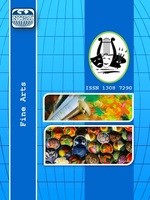MATRIX PROJECTS AS AN EXPERIMENTAL METHOD IN TYPOGRAPHY COURSE
For visual communication design education, experimental typography method is an inspiring design exercise in typography lessons. Not only directing students to coincidental discoveries it also let them For visual communication design education, experimental typography method is an inspiring design exercise in typography lessons. Not only directing students to coincidental discoveries it also let them show new points of view in typography and font design. In particular, constructing typography in an experimental method causes primitive effects and productive results in creatively expressed ideas. Thanks to the disposition of Matrix Typography Projects, which are an experimental typographical method, design students both explore several different ideas to create a font design and find, discover new unique design approaches. In each different structural system, students will be able to find a path for a new font design. This challenging and inspirational typographic exercise, the matrix project, focuses on the letter`s structural properties and teaches the main idea of the font design. This project is beneficial in teaching students an influential way to compose multiple conceptual materials for the font design and generate new ideas in typography education.
Anahtar Kelimeler:
Typography, Visual Communication Design, Matrix, Project, Experimental Typography,
TİPOGRAFİ DERSİNDE DENEYSEL BİR YÖNTEM OLARAK MATRİS PROJELERİ
Görsel iletişim tasarımı eğitimi için deneysel tipografi metodu, tipografi derslerinde ilham verici bir tasarım egzersizidir. Tipografide ve font tasarımında, öğrencileri raslantısal keşifler kadar yeni bakış açılarına doğru da yönlendirmektedir. Özellikle, yaratıcı fikirlerin ifadesinde, tipografiyi deneysel bir yöntemle inşa etmek, primitif etkilere ve verimli sonuçlara sebep olmaktadır. Deneysel tipografik bir yöntem olan, Matris Tipografi Projelerinin tabiatı sayesinde, tasarım öğrencileri hem font tasarımında birçok farklı fikir bulmakta hem de benzersiz tasarım yaklaşımlarını keşfetmektedirler. Her bir farklı yapısal sistemde, öğrenciler yeni bir font tasarımı için bir yol bulmaktadırlar. Bu zorlayıcı ve ilham verici tipografik egzersiz, harfin yapısal özelliklerine odaklanmakta ve font tasarımının ana fikrini öğretmektedir. Bu proje, öğrencilere font tasarımında çoklu kavramsal malzeme oluşturmayı öğretmede ve tipografi eğitiminde yeni fikirler üretmede konularında etkilidir.
Keywords:
Tipografi, Görsel İletişim, Tasarım Eğitimi, Matris Projesi, Deneysel Tipografi, ,
___
- Ambrose, G. and Harris, P., (2009). Grafik Tasarımın Temelleri,
- İstanbul: İnkilap Kitabevi. Becer, E., (2007). Modern Sanat ve Yeni Tipografi. Ankara: Dost Kitabevi.
- Branczyk, A., Nachtwey, J., Nehl H., Schlaich S., and Siebert, J., (2001). Emotional Digital.UK: Thames and Hudson.
- Demir, Ç., (2005). Enhancing Creativity in Art Education through
- Brainstorming. International Journal of Education through Art, 1(2), 153-160. Elam, K., (1990). Expressive Typography the Word as Image. NY:
- Van Rostrand Reinhold. Gonzales Crisp D., (2005). Book Review: Type Design: Radical
- Innovations and Experimentation; Type: The Secret History of Letters; The Education of a Typographer; Thinking with Type: A Critical Guide for Designers, Writers, Editors and Students; Pioneers of Modern Typography, Visual Communication, Retrieved from http://vcj.sagepub.com/content/4/2/165. Mimar Sinan Fine Arts University. (2008). Grafist 12. 12th
- International Istanbul Graphic Design Week. İstanbul: Mimar Sinan Fine Arts University Faculty of Fine Arts Graphic Design Department. Type Addict-ed: The new trend of A to Z Typo-Graphics. (2007).
- Hong Kong: Victionary. Twemlow A., (2008). Grafik Tasarım ne içindir? İstanbul: YEM Yayın.
- Ucar, T.F., (2004). Görsel İletişim ve Grafik Tasarım. İstanbul: İnkilap Yayınevi
- Weill, A., (2007). Grafik Tasarim. Istanbul: Yapi Kredi Kultur Sanat Yayıncılık.
- Willen, B. and Strals, N., (2009). Lettering and Type: Creating
- Letters and Designing Typefaces. New York: Princeton Architectural Press.
- Başlangıç: 2009
- Yayıncı: E-Journal of New World Sciences Academy
